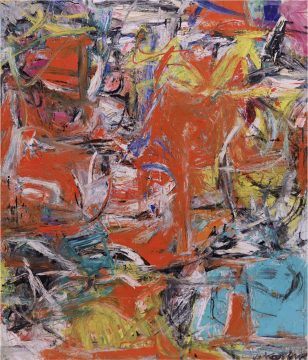Stephen Ellis at the NYRB:

Composition
1955
oil, enamel, and charcoal on canvas
79 1/8 x 69 1/8 inches (201 x 175.6 cm)
In 1955, de Kooning was at one of several artistic peaks. By then, he had completely internalized his synthesis of Cubist structure, including Picasso’s Surrealist variations, with Pollock’s innovative materials and expansive scale. Soutine had shown de Kooning how to charge his refined line with a juicier, more muscular gesture. For twenty years, he’d experimented with the stuff of paint—using commercial house paints, additives like plaster, sand, and charcoal, and every gradation of viscosity from watery washes to lava-like accretions of pigment. This arsenal of effects was now at his spontaneous command and he unleashed it in a series of ambitious abstract paintings that evoke cityscapes or highway vistas. In Composition, the addition of sand or other grit to the paint creates a drag against the canvas, shifting the emphasis from the speed of the stroke to its driving force. It’s as if his hand accelerated hard in first gear in thick, rough passages and then shifted in a heartbeat to fourth, leaping ahead as the suddenly liquid paint splashed across the surface. If you’re not interested in this kind of wild ride, de Kooning isn’t for you.
more here.
